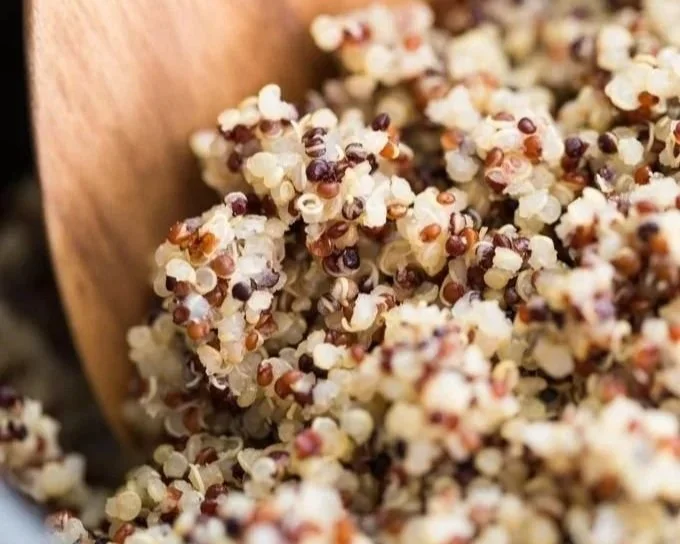Quinoa
Quinoa is often mistaken for a grain, but it is actually a seed from the Chenopodium plant, making it a pseudocereal. Originating from the Andean region of South America, quinoa has been cultivated for over 5,000 years and was a staple food of the Inca civilization. It gained global popularity in the early 2000s as a nutrient-dense, gluten-free alternative to traditional grains.
Today, quinoa is widely used as it has high protein content and can be used to replace other grains in many recipes.
What is Quinoa?
Quinoa (Chenopodium quinoa) is a flowering plant in the amaranth family, closely related to spinach and beets. The plant grows tall, with broad green leaves and clusters of tiny seeds that develop in various colors, including white, red, and black. Quinoa thrives in high-altitude regions with well-draining soil and is known for its resilience in harsh climates. The seeds are harvested once they mature and are typically processed to remove their natural coating of saponins, which can give a bitter taste.
Wash & Store
Quinoa naturally has a coating called saponin that can taste bitter, so rinse it under cold water before cooking. Store uncooked quinoa in an airtight container in a cool, dry place for several months. Cooked quinoa keeps in the fridge for 4–5 days and can be frozen for longer storage.
How to Use Quinoa
Rinse quinoa under cold water to remove any residual bitterness from saponins.
Boil in a pot of salted water until the little spiral (germ) appears and the quinoa is tender with a slight chew.
Or, for a more precise method:
Add 1 cup quinoa to a small pot with 1¾ cups water and a pinch of salt.
Bring to a boil, then turn the heat down to low, cover, and cook for 15 minutes.
Remove from heat and let sit, covered, for another 5 minutes before fluffing with a fork.
For extra flavor, toast the quinoa in a pot with a little oil or butter for about 4 minutes before cooking, until it smells slightly nutty.
Five Ways to Use Quinoa
1. Quinoa Breakfast Bowl
How to Use: Swap oatmeal for quinoa to create a protein-packed breakfast.
Instructions: Cook quinoa (with water, milk, or nut milk), and top with nut butter, sliced berries, a drizzle of honey, and a sprinkle of cinnamon or chopped nuts.
2. Quinoa Salad
How to Use: Add texture and nutrition to your salad.
Instructions: You can add quinoa to any salad to make it more substantial, but a delicious idea is to toss cooked quinoa with mixed greens, chickpeas, roasted sweet potatoes, feta cheese, and a lemon-tahini dressing.
3. Quinoa-Stuffed Peppers
How to Use: Use quinoa as a filling for baked vegetables.
Instructions: Mix cooked quinoa with sautéed onions, garlic, black beans, and diced tomatoes. Stuff into bell peppers, top with cheese, and bake at 375°F for 25 minutes.
4. Quinoa & Herb Veggie Burgers
How to Use: Make a plant-based burger with quinoa.
Instructions: Combine cooked quinoa with mashed black beans, breadcrumbs, eggs, chopped herbs, and spices. Form into patties and pan-fry until golden brown.
5. Quinoa and Veggie Bowl
How to Use: You can really customize this one.
Instructions: Layer cooked quinoa with roasted vegetables, grilled chicken or tofu, avocado, and a flavorful sauce like pesto or tahini dressing.
Quinoa Health Benefits
Complete Protein: Quinoa contains all nine essential amino acids, making it a rare plant-based complete protein.
Rich in Fiber: Eating quinoa supports digestion and promote a healthy gut.
Gluten-Free: As it is not a grain, quinoa is a great alternative for those with gluten sensitivities.
Packed with Micronutrients: It’s high in iron, magnesium, phosphorus, and folate.
Low Glycemic Index: Quinoa can help regulate blood sugar levels and provides sustained energy.
Quinoa Facts
Quinoa was considered the "Mother of All Grains" by the Incas and was used in religious ceremonies.
The United Nations declared 2013 the "International Year of Quinoa" due to its global importance as a nutritious food.
Unlike true grains, quinoa seeds do not come from a grass species, setting it apart botanically from wheat, rice, and barley.
Area 2 Farms for Locals
Your food should be equally accessible and nutritious. Which is where we come in. At Area 2 Farms, we grow fresh organic produce within 10 miles of you.







